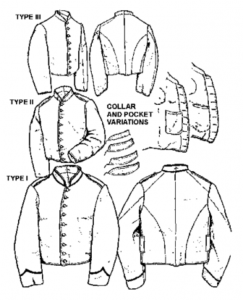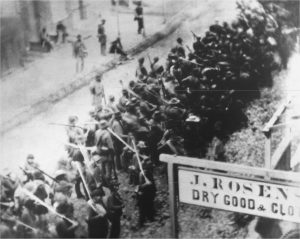Uniform and Equipment Standards
Uniform and equipment standards will be adhered to by all Brigade members. A spirit of uniformity should be stressed. Based on historical research, the Commanding Officer can propose changes to the uniform standard via a 2/3 majority vote of Member Company representatives. Members can propose changes to the uniform standards by forwarding proposals to the Brigade staff for their consideration. Specific event uniform and equipment guidelines may be recommended by the Commanding Officer. They should fit the period of the event being attended and should be directed in a timely manner to the Brigade well in advance of the event. The wearing of federal garments is discouraged within the Brigade.
Jacket – Members are encouraged to acquire two jackets; an early war-style commutation or Richmond Depot Type I jacket, light grey in color with black trim; and a late war-style jacket of blue-grey kersey in the Richmond Depot Type II, Richmond Depot Type III, or Peter Tait style. The Brigade Commander will specify which of these jackets are recommended for an event for greater uniformity and authenticity. Alternatively, members who wish to purchase only a single jacket have the option to acquire a generic Richmond Clothing Bureau-type shell jacket, grey in color, for use at all events.

While there is no definitive dates for when the three shell jacket styles identified by Les Jensen were produced by the Richmond Depot Clothing Bureau, there is a general belief that the first type of jacket may have been produced from the late fall (November) of 1861 until spring of 1862. This “Type I” jacket was similar in construction to a “Type II” jacket described above – with the addition of black piping on the shoulder straps, collar, and sleeve. This jacket is to be made of light to mid gray wool or jean cloth, lined in osnaburg, waverly, cotton drill, or correct color/pattern cotton. Whether the coat is trimmed or not is left up to the discretion of the member, or the member’s unit, but if trim is chosen it should be of black cotton tape. The wearing of these jackets should only be at events that represent 1861 or 1862.
The Richmond Clothing Bureau-type shell jacket which Les Jensen has designated as “Type II” was produced from approximately the spring of 1862 through at least mid-1864, and probably through the end of the war. It was thus the type issued for the longest duration of time from the depot, and was therefore the most common. The Type II jacket is most appropriate for a mid-war impression. The “Type II” shell jacket is characterized by a six piece body and two piece sleeves, with shoulder straps and belt loops, and a nine button front. Jacket should be constructed of wool, satinette, kersey, cassimere or jean cloth, of a non-charcoal grey/dark grey color, which should be purchased from a vendor listed on the Stonewall Brigade approved vendor list. Lined in osnaburg, waverly, cotton drill, or correct color/pattern; the buttons for the jacket are to be either VA state (correct period brass), brass block “I”, Script “I”, Federal Eagle, coin, or plain brass. Pewter buttons are not acceptable. There is to be no colored trim or piping on the jacket unless a member voluntarily chooses to temporarily add black trim to his jacket for purposes of complying with event-specific uniform standards.
Members interested in purchasing a late-war specific uniform jacket may secure a jacket made of blue-grey kersey wool in the pattern of the last two types issued by the Richmond Clothing Bureau (Type II or Type III), or the English style known as the Peter Tait. Due to documentation, this type of jacket should only be worn at events where the period portrayed falls after May 1863. In terms of construction, the only real difference between a Type II and Type III jacket is that Type III jackets did not have shoulder straps or belt loops. In terms of fabric – all surviving Type III jackets are made out of Blue/Grey Kersey imported from England (this material is also referred to as “cadet grey wool kersey” – however, the modern cadet grey bears no resemblance to period English Blue/Grey Kersey). There is a general opinion held by some historians today that Type III jackets produced by the Richmond Depot were exclusively made with English Blue/Grey Kersey. (See Echos of Glory pp. 136-137, 139). At a minimum, 100% grey wool Type III jackets were extremely rare and usually only worn by officers.
Jean Cloth vs. Wool
Richmond Depot Clothing Bureau records found at the National Archives in Washington D.C. indicate that, after late 1862, 100% grey woolen material was not produced in any significant quantity by the mills providing the Clothing Bureau with materials for uniforms. Records indicate that in 1863, for example, approximately 90% of all uniform material produced for the Richmond depot was jean cloth and cassimere.
These materials were usually dyed grey or brownish-grey with natural dyes such as sweet gum bark, logwood, and sumac. The natural dyes would fade with exposure to the sun into a variety of brownish/earth-toned hues. Jean cloth is characterized by a 2/1 twill with a cotton warp and a wool filling, while cassimere cloth has a 2/2 twill. Although no known documentation exists, it is probable that satinette was only utilized for uniform construction by the depot early in the war possibly through mid-1862 – satinette is not as durable as jean cloth and also requires a bit more wool. Technically, satinette also has a woolen weft or fill and a cotton warp like jean cloth – but satinette was loomed in such a manner so that it looks more like an all wool broadcloth – sometimes described as a 4/1 or 5/1 twill.
Shoes – All shoes or boots must be of correct period style, material, and construction. Documented Confederate or U.S. issue brogans; Jefferson Bootee; Low Quarter British Import Shoe. Black or russet leather. Pegged or sewn soles.
Trousers – Trousers are to be of the Richmond Clothing Bureau pattern in kersey or jean, grey in color. A black stripe along the seam is recommended for early war events. Trousers of British Army blue are acceptable for mid-to-late war events.

Headgear:
a) Slouch hats with rolled brim; ribbon around base of crown and brim; high or low crown; colors of black, tan, brown or gray; correct period linings are required.
b) Kepi (not forage cap) should be of same color and materials as for jackets and trousers.
Shirts – Cottons, wool, flannel; military or civilian pattern; with or without collar; cloth of proper colors/patterns to the period.
Eyeglasses – Must be of period style and construction. If you are in doubt, please check with the Brigade Staff.
Leather Gear:
a) Cartridge Box – Black leather; U.S. 1841 (.54 cal.), 1842 (.69 cal), 1855 (.58 cal), Richmond Arsenal copies of these models, or British Enfield pattern are all acceptable. Boxes must have cartridge tins inside. May be worn on either shoulder sling or waist belt.
b) Cap Box – Black leather or tarred canvas; U.S. 1850, shield front, Richmond Arsenal copy, or British Enfield pattern are all acceptable.
c) Waist Belt – Black leather or tarred canvas; buckle to be VA state (state seal in wreath), plain brass, frame (GA. or serpent tongued), British snake, blackened roller, or square C.S.A. plate (eastern theatre model only).
d) Bayonet Scabbard – Black leather or blackened canvas; gaylord pattern (U.S. or C.S.) or British Enfield style are all acceptable.
e) Cartridge Box Sling-Black leather or tarred canvas.
Miscellaneous Equipment:
a) Canteens – Must be carried by all participants in the field. Acceptable styles include Federal M1858 smoothside or M1862 bullseye; C.S. wooden drum; or C.S. Richmond tin drum.
b) Haversacks – Acceptable styles include Federal painted cotton/linen or documented C.S. type.
c) Kapsack-Documented C.S. type, U.S. model 1851 “double bag” (and subsequent late war patterns), U.S. model 1853 “single bag”, or British S. Isaac Campbell & Co. to be used as appropriate for the event.
d) Blanket Rolls-Blankets, oil cloths, gum blankets, and shelter halves must be of period material and construction.
Weapons:
a) Muskets and Rifles – Any serviceable original or reproduction three-band musket or rifled-musket document as being used during the war is acceptable, such as U.S. Model 1816 (converted to percussion); U.S. Models 1842, 1855, 1861, and 1863; Enfield pattern 1842 or 1853; Austrian Lorenz, model 1842; Belgian model 1859; or Richmond Arsenal – first or second model. Must have a bayonet to fit the weapon and be clean, in safe working order, and able to pass inspection as described in Gilham’s Manual.
b) Sidearms – Revolvers are restricted to commissioned officers and must be of period pattern and of percussion ignition. All sidearms must be in good working condition and presented clean and uncapped for inspection.
c) Edged Weapons – Swords may be carried only by officers. Knives may be carried by the rank and file and must be of period pattern and secured in sheaths (see Echos of Glory pp. 78-79; however, large “bowie knives” should be in no way prevalent within the ranks). Bayonets must be carried by all musket-carrying participants and should be serviceable with the weapon they are carrying.
d) Cartridges – Must approximate period construction; of paper, string or glue acceptable. Aluminum foil, tape, staples, and similar closure methods will not be allowed. Cartridges should appear to be authentic. No live rounds will be allowed on your person at inspection.